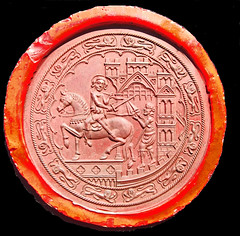
PREV ARTICLE
NEXT ARTICLE
FULL ISSUE
PREV FULL ISSUE
DASSIER'S KINGS AND QUEENS OF ENGLAND MEDALSRegarding the framed plaster medallions reader Whitney Allen asked about, Pete Smith writes: "These are medals of the kings of England including Charles I, George I and William I. "The dies were originally executed by Jean Dassier for a series of 33 medals issued in 1731. Caroline was soon added to the 1731 set to make 34. In 1830 the set was re-issued with George III and George IV added to make 36 in the set." "It is difficult to identify medals when only one side is shown. I do not have any information about a series of such medals being issued in plaster."
Here's some more information from the website of Hedley Betts. -Editor
Dassier's Kings & Queens
The earlier medals were struck on slightly thinner flans with slightly beveled edges. They have a finish that is a little duller. The later issues have slightly more reflective surfaces and vary in the color of their patination. Some show signs of die wear and defects. Examples cast from struck medals also exist. They are slightly smaller in size and poorer in quality.
For more information, see:
Scott Miller writes: "They are plaster casts of medals from the series of Kings and Queens of England by Jean Dassier. The first three are of Charles I, George I, and William the Conqueror, while the last is the reverse of a medal for Queen Caroline done at the same time." Thanks! E-Sylum readers come through again! Scott included a link to images of the medals on Ben Weiss' website. Here's a comparison. -Editor
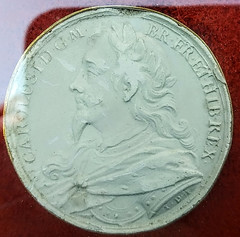
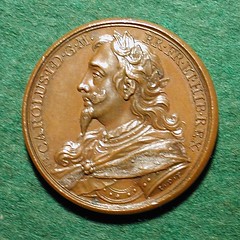
Charles I
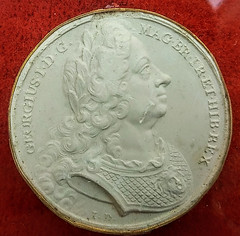

George I
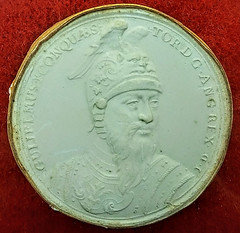
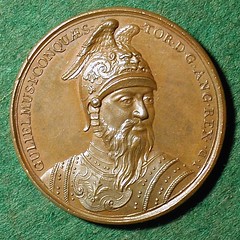
William the Conqueror
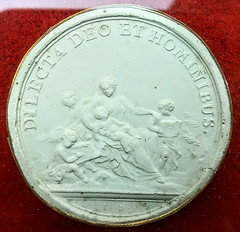

Queen Caroline reverse
For more information, see:
Pete adds: "I have Eimer's book on British Commemorative Medals and their Values (1987). He does not mention plaster versions."
Internet searches for "Dassier plaster medals" lead to several references to offerings, but no information on who made these or when. I reached out to Hedley Betts and Christopher Eimer for more information. -Editor Chris Eimer writes: "Without examining the items in person, they would appear to date from the nineteenth century, the gilt paper surround evident on at least one of those illustrated suggesting that they were to be mounted in the form of a book." Hedley Betts writes: "I have seen plaster copies of Dassier's Kings and Queens. In fact over forty years ago, while I was still living in England I had a set mounted in two frames on the wall of my office. They made an attractive display and a collector from Malta was so taken with them that he eventually persuaded me to sell them. From the age of the frames, I believed them to be Victorian in origin. In fact, it seems to have been a fairly widespread practice in the nineteenth century to make copies of medals and gems and to mount them for display, since I have seen other plaster casts and electrotypes of medals and engraved gems in frames made for wall display. I have also seen them mounted in book-like display cases. "Since they are copies, they don't have much historical or artistic significance. Their value lies more in their decorative appeal. Besides seeing plaster copies of Dassier's medals I have come across double-sided copies made of black basalts and in terra cotta with dates impressed on the reverse. These I also believe to be Victorian in origin, made from molds created from actual medals."
Edward C. Moore of Texas is the Librarian for the Conder Token Collectors Club, and he offered this overview of plaster cameos, illustrated with photos of his own collection. Thanks! -Editor
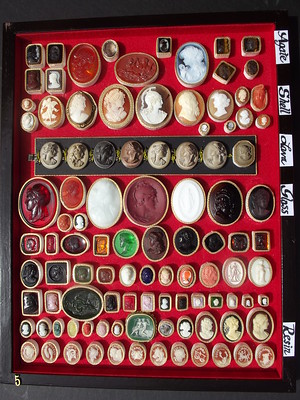
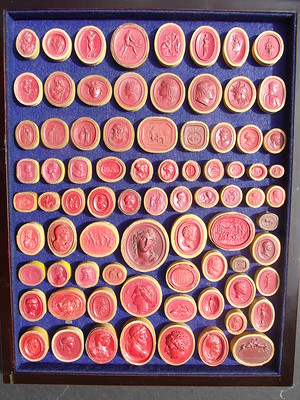
In Egypt, most of the people could not read or write, therefore they could not sign their name. They needed a way to sign their name so small Scarabs were carved with their name on the base carved in intaglio. These small Scarabs had a hole drilled through them and a string was put through the hole and tied around the wrist and the scarab was worn like jewelry. When the owner needed to sign his name, he could press the scarab into a soft clay tablet, and this would be his signature. In Greece and Minoa, they took intaglio carving to the next level and carved pictures into the stone. Sometimes pictures of warriors, or the king, or lions or whatever but these intaglios took months to carve into the stone using spinning wheels and grinding powders so only royalty or very rich people could afford to own a beautifully carved intaglio. The Etruscans copied the Egyptian Scarabs but instead of a name on the base, they carved pictures like the Greeks and Minoans. These were usually carved in carnelian agate and today, if you want to own one, prepare to spend a fortune! When the Romans conquered the Greeks, they saw how great the Greek stone carvers were and so they used them to have their intaglios carved. The roman word for a stone carver who could carve an intaglio was “CAVITOR.” OK, we will skip over most of the dark ages where when people found the intaglios they thought those pictures were put in the stone by God, and they carved little religious symbols into them and gave them to priests and the like. Now we are up to about the year 1550, life has settled down and in Europe and England life is divided into rich folks and poor folks. The rich live in manor housed and the poor work the land and pay taxes to the rich. The children of the rich folks are well educated and after they graduate college, as part of their education, they are sent on what is called “The Grand Tour.” They will spend several years traveling to the great places in Europe such as Paris, Rome, Venice, and Athens. There are no museums, those have not been invented yet, so they stay with other rich folks or royalty and there they see the collections that have been gathered. They want to bring home things that they have seen in Europe! (Hold that thought.”)
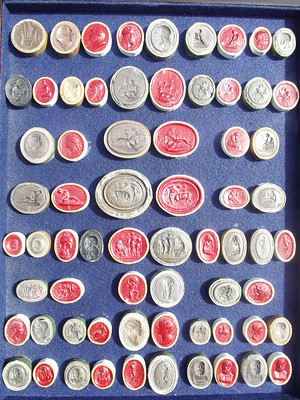
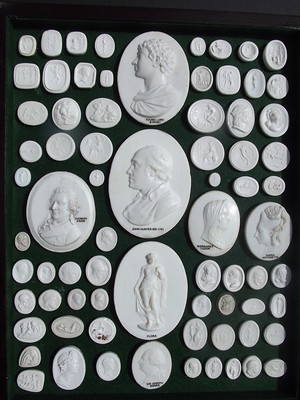
Sulphur Intaglios and Vitreous Glass Paste Cameos You have heard the saying “Signed, Sealed, and Delivered.” This was literal, your signature on a document was not enough because someone could copy it. You had to have a Seal to accompany the signature. They would melt red wax beside your signature, and you would press your personal intaglio seal into the hot wax leaving a cameo impression of your crest or initials or whatever was carved into your seal. Rich folks had them, poor folks did not, and poor folks were jealous! By the time of the Industrial revolution in the late 1700's, every business, school, church, and gentleman had a personal seal. A man named James Tassie began collecting copies of seals. He would make impressions using melted sulfur mixed with red ochre, and his collection grew to thousands of impressions. This was a time of experimentation and he found that he could make copies of famous old seals out of glass. This was called Vitreous Glass Paste. He sells these and now everyone can own an intaglio. Josiah Wedgwood begins making black clay copies of some of them and calls them Basalt Ware. Later he will make the famous white on blue copies and call them Jasper Ware.
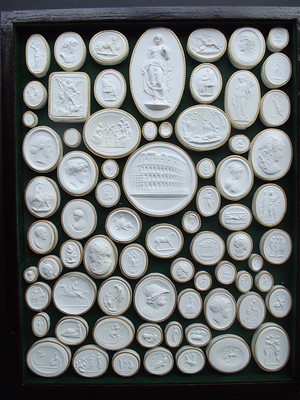
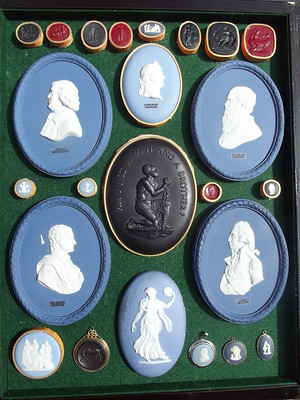
Plaster and Wedgwood Cameos Jump back to Rome where the best seal carvers live and where the rich people are coming on The Grand Tour. A man named Paoletti has been collecting images from seals and he starts making copies of them out of a mixture of ground marble and Plaster of Paris. He puts these impressions in fake books and tourists buy them to take back to England. This is about 1820 now and he scraps the ground marble and uses only plaster of Paris. Some of these got framed and put on the walls of posh houses. People liked collections of things and businessmen such as Wedgwood made sets of images such as Kings of France and Kings of England. Art medals had become popular, but these were expensive. However, plaster copies of art medals were inexpensive and so people would collect plaster copies and frame them. These were usually made with a paper surround with a gilt edge so when you looked at a copy in a frame you saw the white plaster and a gold border. If you owned a large collection of things, you could make plaster copies and sell them. Early museums even allowed collectors to come in and make copies. You will not see that today. Whitney Allen writes: "Thank you! I've been thoroughly educated beyond my seemingly in-depth Google search! I was absolutely fascinated by the extensive information your readers were able to pass on! They truly encompass a wealth of knowledge. So happy to meet a diverse group of historians who are excited to teach and pass on pieces of the past! Blessings to you and each of them for taking time during such a hectic season to encourage my curiosity!"
Thanks, everyone! Great topic. -Editor
To read the earlier E-Sylum article, see:
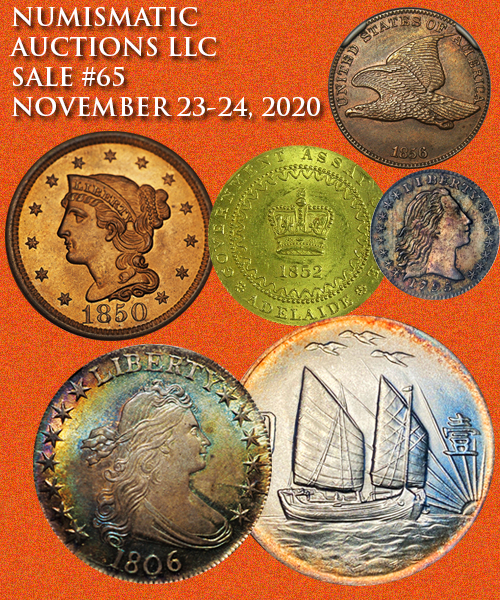
Wayne Homren, Editor The Numismatic Bibliomania Society is a non-profit organization promoting numismatic literature. See our web site at coinbooks.org. To submit items for publication in The E-Sylum, write to the Editor at this address: whomren@gmail.com To subscribe go to: https://my.binhost.com/lists/listinfo/esylum All Rights Reserved. NBS Home Page Contact the NBS webmaster 
|
